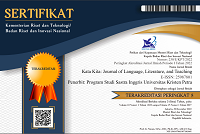Adolf Hitler’s Pathological Narcissistic Personality Disorder in Mein Kampf
DOI:
https://doi.org/10.9744/katakita.9.3.389-397Abstract
Given the argument that an autobiography can be deconstructed like any other fictional texts, this article analyzes Mein Kampf (1939), an autobiography written by Adolf Hitler by treating the text as a fiction. Doing so reveals Adolf Hitler the character, who is very influenced by Adolf Hitler the writer. With the use of Otto F. Kernberg’s (2004) theory on pathological narcissistic personality disorder, this article attempts to find Adolf Hitler the character’s narcissistic personality disorder inside of Mein Kampf and the reasons for such personality disorder. The investigation reveals that the symptoms of the character’s narcissism can be found in the character’s self, emotional life, and social functioning which fit into Kernberg’s (2004) description of a narcissistic patient. On the other hand, the character’s authoritarian parental figure and innate talents are the reasons for the personality disorder.
Keywords: autobiography; narcissism; adolf hitler; mein kampf
References
Baumeister, R. F. (1999). Self-concept, self-esteem, and identity. In V. J. Derlega, B. A. Winstead, & W. H. Jones (Eds.), Personality: Contemporary theory and research (pp. 339–375). Nelson-Hall Publishers.
Baumrind, D. (1966). Effects of authoritative parental control on child behavior. Child Development, 37(4), 887-907. https://doi.org/10.2307/1126611
Baumrind, D. (1991). The influence of parenting style on adolescent competence and substance use. The Journal of Early Adolescence, 11(1), 56–95. https://doi.org/10.1177/0272431691111004
Berryman, C. (1999). Critical mirrors: Theories of autobiography. Mosaic: An Interdisciplinary Critical Journal, 32(1), 71-84. http://www.jstor.org.ezproxy.dewey.petra.ac.id:2048/stable/44029420
Coolidge, F.L., Davis, F.L., & Segal, D.L. (2007). Understanding madmen: A dsm-iv assessment of Adolf Hitler. Individual Differences Research, 5(1), 30-43.
Chilton, P. (2015). Manipulation, memes and metaphors: The case of mein kampf. In L.D. Saussure & P. Schulz (Eds.). Manipulation and Ideologies in the Twentieth Century (7th vol., pp. 15-44). John Benjamins Publishing Company.
Dewar, G. (2017, June). Authoritarian parenting: What happens to the child? Parenting Science. https://www.parentingscience.com/authoritarian-parenting.html
Dombek, K. (2016). The selfishness of others. Farrar, Straus and Giroux.
Farber, L. (1966). Ways of the will. Basic Books
Hamann, B. (2011). Hitler’s Vienna. Tauris Parke
Hoffman, H. (2012). Hitler was my friend. Frontline Books. (Original work published 1955).
Hitler, A. (1939). Mein kampf. (Murphy, J, Trans.). Hurst and Blacklett LTD. (Original work published 1925).
Jay, P. (1987). What's the use? critical theory and the study of autobiography. Biography, 10(1), 39-54. http://www.jstor.org/stable/23539298
Kernberg, O. F. (2004). Borderline conditions and pathological narcissism. Rowman & Littlefield Publishers, Inc.
Langer, W. C. (1972). The mind of Adolf Hitler: The secret wartime report. Basic Books, Inc.
Lee, S. U. (2004). Constructing an aesthetic weltanschauung: Freud, James, and Ricoeur. Journal of Religion and Health 43, 273-290. https://doi.org/10.1007/s10943-004-4297-5
Malabou, C. (2013). Go wonder: Subjectivity and affects in neurobiological times. In C. Malabou & A. Johnston (Eds.). Self and emotional life (pp. 3-63). Columbia University Press.
Olderbak, S., Sassenrath, C., Keller, J., & Wilhelm, O. (2014). An emotion-differentiated perspective on empathy with the emotion specific empathy questionnaire. Frontiers in Psychology, 5(653), 1-14. https://doi.org/10.3389/fpsyg.2014.00653
Stets, J. & Burke, P. (2000). Identity theory and social identity theory. Social Psychology Quarterly, 63(3), 224-237. https://doi.org/10.2307/2695870
Stines, S. (2019, February 10). What is narcissistic supplies? Psychcentral. https://psychcentral.com/pro/recovery-expert/2019/02/what-is-narcissistic-supply#1
Toland, J. (1992). Adolf Hitler. Anchor Books
Downloads
Published
Issue
Section
License
Authors who publish with this journal agree to the following terms:- Authors retain copyright and grant the journal right of first publication with the work simultaneously licensed under a Creative Commons Attribution License that allows others to share the work with an acknowledgement of the work's authorship and initial publication in this journal.
- Authors are able to enter into separate, additional contractual arrangements for the non-exclusive distribution of the journal's published version of the work (e.g., post it to an institutional repository or publish it in a book), with an acknowledgement of its initial publication in this journal.
- Authors are permitted and encouraged to post their work online (e.g., in institutional repositories or on their website) prior to and during the submission process, as it can lead to productive exchanges, as well as earlier and greater citation of published work (See The Effect of Open Access).














